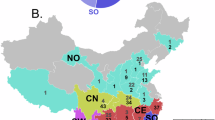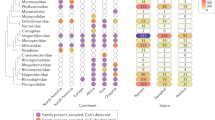Abstract
The extent to which humans facilitate zoonotic transmission of infectious diseases is unclear. Human encroachment into wildlife habitats as a consequence of expanding urbanization, cropland area and intensive animal farming is hypothesized to favour the emergence of zoonotic diseases. Here we analyse comprehensive, high-resolution datasets on forest cover, cropland distribution, livestock density, human population, human settlements, bat species’ distribution and land-use changes in regions populated by Asian horseshoe bats (>28.5 million km2)—the species that most commonly carry severe acute respiratory syndrome (SARS)-related coronaviruses. We identify areas at risk of SARS-related coronavirus outbreaks, showing that areas in China populated by horseshoe bats exhibit higher forest fragmentation and concentrations of livestock and humans than other countries. Our findings indicate that human–livestock–wildlife interactions in China may form hotspots with the potential to increase SARS-related coronavirus transmission from animals to humans.
This is a preview of subscription content, access via your institution
Access options
Access Nature and 54 other Nature Portfolio journals
Get Nature+, our best-value online-access subscription
$32.99 / 30 days
cancel any time
Subscribe to this journal
Receive 12 digital issues and online access to articles
$119.00 per year
only $9.92 per issue
Buy this article
- Purchase on SpringerLink
- Instant access to full article PDF
Prices may be subject to local taxes which are calculated during checkout






Similar content being viewed by others
References
Jones, K. E. et al. Global trends in emerging infectious diseases. Nature 451, 990–993 (2008).
Rulli, M. C., Santini, M., Hayman, D. T. & D’Odorico, P. The nexus between forest fragmentation in Africa and Ebola virus disease outbreaks. Sci. Rep. 7, 41613 (2017).
Espinosa, R., Tago, D. & Treich, N. Infectious diseases and meat production. Environ. Resource Econ. 76, 1019–1044 (2020).
Young, H., Griffin, R. H., Wood, C. L. & Nunn, C. L. Does habitat disturbance increase infectious disease risk for primates? Ecol. Lett. 16, 656–663 (2013).
Gottdenker, N. L., Streicker, D. G., Faust, C. L. & Carroll, C. R. Anthropogenic land use change and infectious diseases: a review of the evidence. EcoHealth 11, 619–632 (2014).
Rohr et al. Emerging human infectious diseases and the links to global food production. Nat. Sustain. 2, 445–456 (2019).
Zhou, P. et al. A pnemonia outbreak associated with a new coronavirus of probable bat origin. Nature 579, 270–273 (2020).
Lam, T. T. et al. Identifying SARS-CoV-2 related coronaviruses in Malayan pangolins. Nature 583, 282–285 (2020).
Tilman, D. & Clark, M. Global diets link environmental sustainability and human health. Nature 515, 518–522 (2014).
Hassell, J. M., Begon, M., Ward, M. J. & Fèvre, E. M. Urbanization and disease emergence: dynamics at the wildlife–livestock–human interface. Trends Ecol. Evol. 32, 55–67 (2017).
Shah, H. A., Huxley, P., Elmes, J. & Murray, K. A. Agricultural land-uses consistently exacerbate infectious disease risks in Southeast Asia. Nat. Commun. 10, 4299 (2019).
Godfray, H. C. J. et al. Meat consumption, health, and the environment. Science 361, eaam5324 (2018).
Delgado, C., Rosegrant, M., Steinfeld, H., Ehui, S. & Courbois, C. Livestock to 2020: The Next Food Revolution. Food, Agriculture, and the Environment Discussion Paper 28 (International Food Policy Research Institute, 1999).
Coker, R. et al. Towards a conceptual framework to support one-health research for policy on emerging zoonoses. Lancet Infect. Dis. 11, P326–P331 (2011).
Wu et al. Economic growth, urbanization, globalization, and the risks of emerging infectious diseases in China: a review. Ambio 46, 18–29 (2017).
Wilkinson, D. A., Marshall, J. C., French, N. P. & Hayman, D. T. Habitat fragmentation, biodiversity loss and the risk of novel infectious disease emergence. J. R. Soc. Interface 15, 20180403 (2018).
Johnson, C. K. et al. Global shifts in mammalian population trends reveal key predictors of virus spillover risk. Proc. R. Soc. B 287, 20192736 (2020).
Bloomfield, L. S. P., McIntosh, T. L. & Lambin, E. F. Habitat fragmentation, livelihood behaviors, and contact between people and nonhuman primates in Africa. Landsc. Ecol. 35, 985–1000 (2020).
Pulliam, J. R. et al. Agricultural intensification, priming for persistence and the emergence of Nipah virus: a lethal bat-borne zoonosis. J. R. Soc. Interface 9, 89–101 (2012).
Zhou, P. et al. Fatal swine acute diarrhoea syndrome caused by an HKU2-related coronavirus of bat origin. Nature 5556, 255–258 (2018).
Allen, T. et al. Global hotspots and correlates of emerging zoonotic diseases. Nat. Commun. 8, 1124 (2017).
Meyer, C. F., Struebig, M. J. & Willig, M. R. in Bats in the Anthropocene: Conservation of Bats in a Changing World (eds Voigt, C.C. & Kingston, T.) 63–103 (Springer, 2016).
Gibb, R. et al. Zoonotic host diversity increases in human-dominated ecosystems. Nature 584, 398–402 (2020).
Cui, J., Li, F. & Shi, Z. Origin and evolution of pathogenic coronaviruses. Nat. Rev. Microbiol. 17, 181–192 (2019).
Hul V. et al. A novel SARS-CoV-2 related coronavirus in bats from Cambodia. Preprint at https://doi.org/10.1101/2021.01.26.428212 (2021).
Murakami, S. et al. Detection and characterization of bat Sarbecovirus phylogenetically related to SARS-CoV-2, Japan. Emerg. Infect. Dis. 26, 3025 (2020).
Wacharapluesadee, S. et al. Evidence for SARS-CoV-2 related coronaviruses circulating in bats and pangolins in Southeast Asia. Nat. Commun. 12, 972 (2021).
Soman Pillai, V., Krishna, G. & Valiya Veettil, M. Nipah virus: past outbreaks and future containment. Viruses. 12, 465 (2020).
Weingartl, H. M. et al. Susceptibility of pigs and chickens to SARS coronavirus. Emerg. Infect. Dis. 10, 179–184 (2004).
Schlottau, K. et al. SARS-CoV-2 in fruit bats, ferrets, pigs, and chickens: an experimental transmission study. Lancet Microbe 1, e218–e225 (2020).
Munnink, B. B. O. et al. Transmission of SARS-CoV-2 on mink farms between humans and mink and back to humans. Science 371, 172–177 (2021).
Zhou, L. et al. The re‐emerging of SADS‐CoV infection in pig herds in southern China. Transbound. Emerg. Dis. 66, 2180–2183 (2019).
Thuiller, W., Lafourcade, B., Engler, R. & Araújo, M. B. BIOMOD—a platform for ensemble forecasting of species distributions. Ecography 32, 369–373 (2009).
Chinazzi, M. et al. The effect of travel restrictions on the spread of the 2019 novel coronavirus (COVID-19) outbreak. Science 368, 395–400 (2020).
Yang, Q. et al. Assessing the role of live poultry trade in community-structured transmission of avian influenza in China. Proc. Natl Acad. Sci. USA 117, 5949–5954 (2020).
D’Odorico, P. et al. The global food–energy–water nexus. Rev. Geophys. 56, 456–531 (2018).
Meyfroidt, P., Lambin, E. F., Erb, K. H. & Hertel, T. W. Globalization of land use: distant drivers of land change and geographic displacement of land use. Curr. Opin. Environ. Sustain. 5, 438–444 (2013).
Ning, J. et al. Spatiotemporal patterns and characteristics of land-use change in China during 2010–2015. In J. Geogr. Sci. 28, 547–562 (2018).
Chen, C. et al. China and India lead in greening of the world through land-use management. Nat. Sustain. 2, 122–129 (2019).
Liu, J. et al. Forest fragmentation in China and its effect on biodiversity. Biol. Rev. 94, 1636–1657 (2019).
Whitmee, S. et al. Safeguarding human health in the Anthropocene epoch: report of the Rockefeller Foundation–Lancet Commission on planetary health. Lancet 386, 1973–2028 (2015).
Andersen, K. G., Rambaut, A., Lipkin, W. I., Holmes, E. C. & Garry, R. F. The proximal origin of SARS-CoV-2. Nat. Med. 26, 450–452 (2020).
Dietz, C., Dietz, I., Ivanova, T. & Siemers, B. M. Seasonal and regional scale movements of horseshoe bats (Rhinolophus, Chiroptera: Rhinolophidae) in northern Bulgaria. Nyctalus NF 14, 52–64 (2009).
Wang, J. et al. Seasonal habitat use by greater horseshoe bat Rhinolophus ferrumequinum (Chiroptera: Rhinolophidae) in Changbai Mountain temperate forest, northeast China. Mammalia 74, 257–266 (2010).
Robinson, T. P. et al. Mapping the global distribution of livestock. PLoS ONE 9, e96084 (2014).
Teluguntla, P. et al. in Land Resources: Monitoring, Modelling, and Mapping, Remote Sensing Handbook Vol. II (eds Prasad, S. & Thenkabail, P. S.) Ch. 7 (CRC Press Inc, 2014).
Hansen, M. C. et al. High-resolution global maps of 21st-century forest cover change. Science 342, 850–853 (2013).
Gilbert, M. et al. Global distribution data for cattle, buffaloes, horses, sheep, goats, pigs, chickens and ducks in 2010. Sci. Data 5, 180227 (2018).
Congalton, R. G. et al. NASA Making Earth System Data Records for Use in Research Environments (MEaSUREs) Global Food Security-support Analysis Data (GFSAD) @ 30-m: Cropland Extent Validation (GFSAD30VAL) (NASA EOSDIS Land Processes DAAC, 2017); https://doi.org/10.5067/MEaSUREs/GFSAD/GFSAD30VAL.001
Nieves, J. J. et al. Annually modelling built-settlements between remotely-sensed observations using relative changes in subnational populations and lights at night. Comput. Environ. Urban Syst. 80, 101444 (2020).
Vogt, P., Riitters, K. H., Estreguil, C. J., Kozak, T. G. & Wade, J. D. Wickham mapping spatial patterns with morphological image processing. Landsc. Ecol. 22, 171–177 (2007).
Assuncao, R. M., Neves, M. C., Camara, G. & Da Costa Freitas, C. Efficient regionalisation techniques for socio-economic geographical units using minimum spanning trees. Int. J. Geogr. Inf. Sci. 20, 797–811 (2006).
Acknowledgements
M.C.R and N.G. are supported by the ENI Enrico Mattei Foundation (FEEM), the Cariplo Foundation (SusFeed project 0737 CUP D49H170000300007) and Regione Lombardia (RUD0CONV01/ASSO project D44I20002000002). D.T.S.H. is supported by Royal Society Te Apārangi Rutherford Discovery Fellowship RDF‐MAU1701 MAU1701 and Bryce Carmine and Anne Carmine (née Percival), through the Massey University Foundation.
Author information
Authors and Affiliations
Contributions
M.C.R. designed the research. M.C.R., N.G. and D.T.S.H performed the research. M.C.R., P.D. and N.G. analysed the data. P.D., M.C.R. and D.T.S.H wrote the paper.
Corresponding author
Ethics declarations
Competing interests
The authors declare no competing interests.
Additional information
Peer review information Nature Food thanks Ruediger Schaldach, Xia Li and the other, anonymous, reviewer(s) for their contribution to the peer review of this work.
Publisher’s note Springer Nature remains neutral with regard to jurisdictional claims in published maps and institutional affiliations.
Supplementary information
Supplementary Information
Supplementary Tables 1–6 and Figs. 1–15.
Rights and permissions
About this article
Cite this article
Rulli, M.C., D’Odorico, P., Galli, N. et al. Land-use change and the livestock revolution increase the risk of zoonotic coronavirus transmission from rhinolophid bats. Nat Food 2, 409–416 (2021). https://doi.org/10.1038/s43016-021-00285-x
Received:
Accepted:
Published:
Issue date:
DOI: https://doi.org/10.1038/s43016-021-00285-x
This article is cited by
-
Viral emergence and pandemic preparedness in a One Health framework
Nature Reviews Microbiology (2025)
-
Applying a systems thinking approach to evaluating the effectiveness of Africa’s foodborne disease surveillance systems
Communications Medicine (2025)
-
Pathogens and planetary change
Nature Reviews Biodiversity (2025)
-
Forest Fragmentation and Warmer Climate Increase Tick-Borne Disease Infection
EcoHealth (2025)
-
Impacts of climate change-related human migration on infectious diseases
Nature Climate Change (2024)



